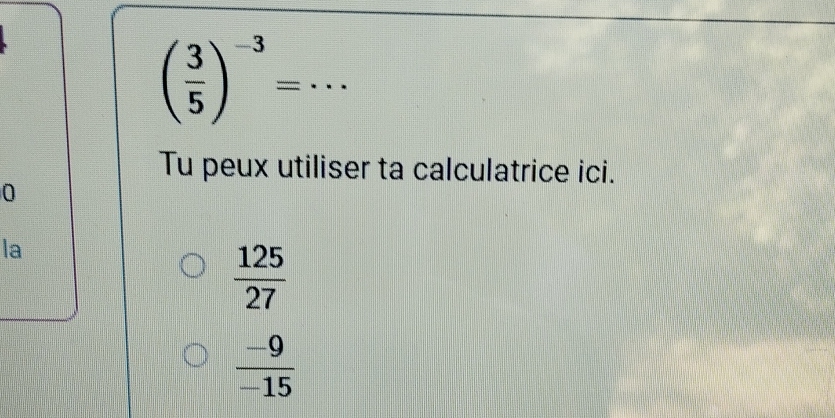Simplifier l'expression mathématique (3/5)^-3.

Understand the Problem
La question demande de simplifier l'expression mathématique (3/5)^-3. Cela implique de comprendre comment les exposants négatifs fonctionnent et comment les appliquer à une fraction. Essentiellement, un exposant négatif signifie que nous devons prendre l'inverse de la base élevée à l'exposant positif.
Answer
$\frac{125}{27}$
Answer for screen readers
$\frac{125}{27}$
Steps to Solve
-
Rewrite the expression with a positive exponent A negative exponent indicates that we should take the reciprocal of the base raised to the positive exponent. $$ \left(\frac{3}{5}\right)^{-3} = \left(\frac{5}{3}\right)^{3} $$
-
Apply the exponent to both the numerator and the denominator To cube a fraction, we raise both the numerator and the denominator to the power of 3. $$ \left(\frac{5}{3}\right)^{3} = \frac{5^3}{3^3} $$
-
Calculate $5^3$ and $3^3$ $5^3 = 5 \times 5 \times 5 = 125$ $3^3 = 3 \times 3 \times 3 = 27$
-
Write the simplified fraction $$ \frac{5^3}{3^3} = \frac{125}{27} $$
$\frac{125}{27}$
More Information
The expression $\left(\frac{3}{5}\right)^{-3}$ simplifies to $\frac{125}{27}$. This means that $\left(\frac{3}{5}\right)^{-3}$ is equivalent to $\frac{125}{27}$.
Tips
A common mistake is to apply the negative exponent only to the numerator or only to the denominator, instead of taking the reciprocal of the entire fraction first. Another mistake is to incorrectly calculate the cubes of 3 or 5.
AI-generated content may contain errors. Please verify critical information